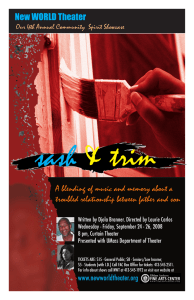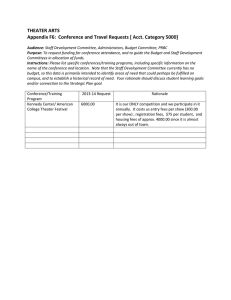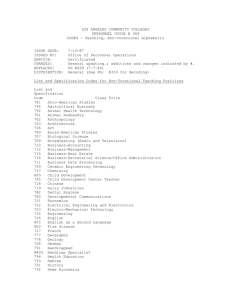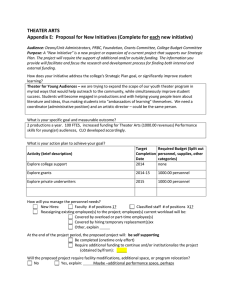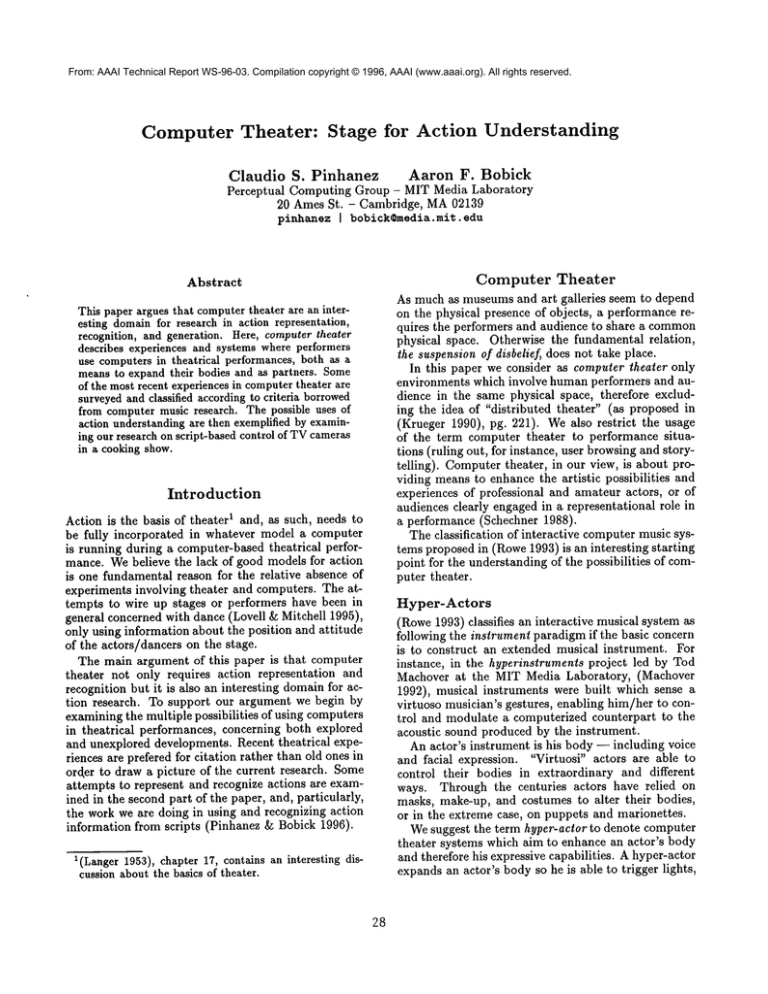
From: AAAI Technical Report WS-96-03. Compilation copyright © 1996, AAAI (www.aaai.org). All rights reserved.
Computer Theater:
Claudio
Stage
for Action
S. Pinhanez
Understanding
Aaron F. Bobick
Perceptual Computing Group - MIT Media Laboratory
20 Ames St. - Cambridge, MA02139
pinhanozI bobick~media.mit.edu
Computer
Abstract
Theater
As much as museumsand art galleries seem to depend
on the physical presence of objects, a performance requires the performers and audience to share a common
physical space. Otherwise the fundamental relation,
the suspension of disbelief~ does not take place.
In this paper we consider as computer theater only
environments which involve human performers and audience in the same physical space, therefore excluding the idea of "distributed theater" (as proposed in
(Krueger 1990), pg. 221). Wealso restrict the usage
of the term computer theater to performance situations (ruling out, for instance, user browsingand storytelling). Computertheater, in our view, is about providing means to enhance the artistic possibilities and
experiences of professional and amateur actors, or of
audiences clearly engaged in a representational role in
a performance (Schechner 1988).
The classification of interactive computer music systems proposed in (Rowe1993) is an interesting starting
point for the understanding of the possibilities of computer theater.
This paper argues that computertheater are an interesting domainfor research in action representation,
recognition, and generation. Here, computer theater
describes experiences and systems where performers
use computers in theatrical performances, both as a
meansto expand their bodies and as partners. Some
of the most recent experiences in computertheater are
surveyedand classified according to criteria borrowed
from computer music research. The possible uses of
action understanding are then exemplified by examining our research on script-based control of TVcameras
in a cooking show.
Introduction
Action is the basis of theater 1 and, as such, needs to
be fully incorporated in whatever model a computer
is running during a computer-based theatrical performance. Webelieve the lack of good models for action
is one fundamental reason for the relative absence of
experiments involving theater and computers. The attempts to wire up stages or performers have been in
general concerned with dance (Lovell ~ Mitchell 1995),
only using information about the position and attitude
of the actors/dancers on the stage.
The main argument of this paper is that computer
theater not only requires action representation and
recognition but it is also an interesting domainfor action research. To support our argument we begin by
examining the multiple possibilities of using computers
in theatrical performances, concerning both explored
and unexplored developments. Recent theatrical experiences are prefered for citation rather than old ones in
order to draw a picture of the current research. Some
attempts to represent and recognize actions are examined in the second part of the paper, and, particularly,
the work we are doing in using and recognizing action
information from scripts (Pinhanez & Bobiek 1996).
Hyper-Actors
(Rowe1993) classifies an interactive musical system
following the instrument paradigm if the basic concern
is to construct an extended musical instrument. For
instance, in the hyperinstruments project led by Tod
Machover at the MIT Media Laboratory, (Machover
1992), musical instruments were built which sense
virtuoso musician’s gestures, enabling him/her to control and modulate a computerized counterpart to the
acoustic sound produced by the instrument.
An actor’s instrument is his body -- including voice
and facial expression. "Virtuosi" actors are able to
control their bodies in extraordinary and different
ways. Through the centuries actors have relied on
masks, make-up, and costumes to alter their bodies,
or in the extreme case, on puppets and marionettes.
Wesuggest the term hyper-actor to denote computer
theater systems which aim to enhance an actor’s body
and therefore his expressive capabilities. A hyper-actor
expandsan actor’s body so he is able to trigger lights,
l(Langer 1953), chapter 17, contains an interesting discussion about the basics of theater.
28
played on a stage screen. Most of the interesting
cases come from the research oriented towards direct
user interaction with computer-generated characters
for game-like systems. Worthy of mention is the work
of Bruce Blumberg (Maes et al. 1995) in building
computer graphics generated dog which interacts with
the user, not only obeying simple gestural commands
(sit, catch the ball) but also having its ownagenda
necessities (drinking, urinating).
An interesting
Mternative is being developed by
Flavia Sparacino, (Sparacino 1996), who is incorporating behavior-based interaction into text, pictures,
and video, constituting what she calls media-creatures.
The project also involves exploring media-creatures in
dance and theater performances -- media-actors. Similarly, computer-actors can be computer-generated objects which do not exist in the real world (or do not
normally interact with people). For example, Sommerer and Mignonneau6 developed an art installation
where fractal-based images of plants grow when the
user touches a real plant in the space. Actors and
7.
dancers can also be embodied in robots
sounds, or images on a stage screen; to control his final appearance to the public if his image or voice is
mediated through the computer; to expand its sensor
capabilities by receiving information on earphones or
video goggles; or to control physical devices like cameras, parts of the set, robots, or the theater machinery.
The idea has been more explored in dance and music
than in theater. Body suits wired with sensors having been widely explored with, recently in the works
of Troika Ranch2. Other examples include the performances of Laurie Anderson involving the processing of
her voice and singing through a Synclavier, (Anderson
1991); George Coates’ experimentation with actors receiving the script from Internet users during the live
performance of "Better Bad News"3; and Christopher
Janney’s performances where a musician and a dancer
4.
played with the sound of their heartbeats
Another possibility is having the actor not on stage,
and providing him the means to control the physical
appearance of his image to the audience. Mark 1%aney’s "Virtual Theater", (Reaney 1996), is a curious
illustration of this concept. In a typical scene an actor
on stage plays with an off-stage actor whose image is
seen by the audience on two large stereo-graphic video
screens (the audience wears special 3D-goggles). The
off-stage actor’s image expands and contracts according to the play events and is used to symbolize and
enrich the power struggle portrayed in the scene.
Rehearsal
vs. Performance
Ensemble rehearsing is a key part of the artistic process of theater. Comparedto music, the ensemble rehearsal process in theater is longer and richer in experimentation. Characters are usually built through the
interaction between actors on the stage with decisive
supervision and guidance coming from the director.
Performing with a bad actor is bad, but rehearsing
with a bad actor is quite worse. An unmotivated or
limited actor in rehearsal can stop the creative process
of the whole company. The importance of rehearsal is
a major point that most of the computer theater experiments so far have inadequately addressed, especially
in the case of computer-actors.
Accordingto this view, one of the biggest challenges
in computer-theater is to build hyper- or computeractors which can actively respond to variations in the
staging of a script as they are discovered and proposed during rehearsal time by the other actors and by
the director. Such rehearsable computer-actors probably require more action representation and recognition than performance-only computer-actors, as is explained later.
Computer-Actors
The player paradigm in interactive music systems corresponds to situations where the intention is to build
"... an artificial player, a musical presence with a personality and behavior of its own..."5. In the computer
theater realm the player paradigm corresponds to the
computer-actor, a computer program which interacts
with human actors, assuming the role of one of the
characters of the play. In this case the computer displays its actions using an output device such as video
screens, monitors, speakers, or physical devices.
The distinction between hyper- and computer-actors
is important because computer-actors require a control system which decides what to do "independently"
of the desires of the human partners. A computeractor must be able to follow the script (if there is one)
and react according to its own role; here, the issues
of action recognition and automatic control of expressiveness seem to be more relevant than in the case of
hyper-actors. In contrast, hyper-actors are likely to
require much better sensing of the human performer
movements than computer-actors.
A straightforward implementation of computer actors would be human-like or cartoonish characters dis-
Scripts
and Improvisations
(Rowe 1993) also distinguishes
between score- and
performance-driven computer music, which we map to
the concepts of scripted and improvisational computer
theater. Scripted computer theater systems are supposed to follow totally or partially the sequence of actions described in a script. During the performance
2http ://www. art. net/Studios/Performance/Dance/
Tro ika_Ranch/Tro
ikallome,html
3http ://www. georgecoates. org/
4 http://www,j anney,com/heartb,htm
S(Rowe 1993),
6http ://www.mic. atr. co. jp/-christa/
7http ://guide.stanford,edu/people/curt is/
machoreo .html
pg.
29
appearance of backdrops and props, or controlling machinery. An example is the Intelligent Stage project
at Arizona State University, (Lovell & Mitchell 1995),
which enables the mapping of volumes in the 3D space
to MIDI outputs. Movement and presence are monitored by 3 cameras, triggering music and lights accordingly.
the system synchronizes the on-going action with the
script, giving back its "lines" as they were determined
during the rehearsal process or, less interestingly, in an
off-line modeby the director.
Improvisational theater relies on well-defined characters and/or situations. This type of computer theater
has immediate connections with the research on developing characters for computer games and software
agents (Bates, Loyall, & Reilly 1992; Maesel al. 1995).
However,the distinction between actor/situation is not
present in most cases, impoverishing the theatrical interest in such creatures since a major source of dramatic conflict in improvisations is the setting of characters in unexpected situations and environments.
Yet more important is the fact that good improvisation requires recognition of intentions. Knowingwhat
the other character wants to do enables interesting and
rich counteracting behavior. Otherwise, the resulting
piece is flat, structurally resembling a "dialogue" with
an animal: the sense of immediacydictates most of the
actions.
Performers
Action-Based
Theater
It is certainly possible to have a computertheater system which just produces output in pre-determined and
pre-timed ways. Although human actors (and especially dancers) can adjust their performances to such
situations, the results normally are devoid of richness
and life. Computer theater seems to be worthwhile
only if the hyper- or computer-actor follows the actions of its humanpartners and adjusts its reactions
accordingly.
In the case of scripted theater the computer system
must be able to recognize the actions being performed
by the human actors, and to match them with the information from the script. Minimally, the computer
can use a list describing mappings between sensory inputs and the corresponding computer-generated outputs. The list can be provided manually by the "director" or technical assistants, and, during performance,
the recognition consists in synchronizing live action
and the list according to the sensory mappings.
Although the "simple" system just described is hard
to implement in practice due to noisy sensors and performance variability, we believe there is a muchmore
interesting approach to computer theater based on action understanding. Instead of providing a computeractor a list of sensor-reaction cryptic mappings, the
challenge is to use as input the actions and reactions
as determined by a script or by the director.
Textual description of actions in the script corresponding to the human part can then be analyzed by
the computer producing visual and auditory components which can be detected by sensory routines. On
the other hand, the hyper- or computer-actor’s actions
can be used to directly generate low-level instructions
for computer-graphics or external physical devices. According to this view, a computer-actor should be instructed by words like "shout" or "whisper", and be
able to recognize automatically an action described
simply as "actor walks to the chair".
A positive feature of action-based verbal descriptions
is precisely their vagueness. A description like "actor
walks to the chair" does not specify from where the
actor comes, the path taken, etc. Instead, it highlights only the final destination enabling the actor to
explore different ways of performing it without disengaging the recognition system. Similarly, describing the computer-actor’s actions in textual modeprovides room for reactive mechanisms during rehearsal
and performance time.
and Users
Most of the research on building interactive
computer characters has been targeted towards non-actors,
people unfamiliar with the computerized environment/space. This is not the case in computer music,
where there has been a concentration in providing tools
for people with some musical training.
Although the development of ideas and methods to
concretely engage users is very important, we believe
it is also very important to concentrate some effort
on understanding and reacting to actors and audience
in a performance situation. There is also an important reason to do so: users are boring from the action
point of view. Users are motivated by curiosity, and
their repertoire of displayed actions and reactions is
normally very restricted.
It is also very hard to develop a performance with
people who are not committed to being engaged -- as
street performers well know. A system assuming nonengaged users must rely on story-telling
techniques
(and therefore, narrative) to create an interesting environment. Theater and, in general, performance can go
beyond story-telling
by assuming that performers and
audience knowtheir roles, actions, and reactions.
Computerized
Computer
Stages
It is worth mentioning another dimension of computer
theater which is concerned with the expansion of the
possibilities for the stage, set, props, costumes, light
and sound. The fundamental distinction
with the
hyper- and computer-actors is that elements of computerized stages are not characters or representations
of characters.
A stage can react by changing illumination, generating visual and special sound effects, changing the
3O
However, in the case of improvisational computeractors it is also necessary to deal with the recognition
of the intentions behind the actions of the humanactor.
For example, consider an improvisational act where an
actor is in jail, and the computer-actor is the prison
guard. In this situation,
the computer system must
recognize whether the prisoner is trying to escape from
the jail and which means he intends to use. Those intentions are embodied, translated into the actor’s physical activities and the recognition system must infer
their occurrence in order to react properly. Perceptual
recognition of intentions has been hardly explored, and
we believe it constitutes a major challenge for the design of interesting improvisational computer-actors.
ters. Therefore, theater enables us to assume that every action is intentional and the result of the conflict
between the character’s objectives and the other actors’ actions: intentions can be expected to be explicit
and present in every activity.
Thus, systems without any capabilities for representing intentions tend to be inadequate for computer theater -- and particularly, for rehearsal -- because they
lack the ability to react purposefully to a given situation or to an action from one of the humanactors.
Action: Representation, Recognition,
and Generation
In this section we try to examinethe different aspects
and challenges for AI research posed by action representation and recognition: in particular we detail some
work we have been doing in terms of representing, using, and recognizing actions in a scripted performance
(Pinhanez & Bobick 1996). Most of this research considers the domain of TV cooking shows, and has been
applied in the development of SmartCams, automatic
cameras for TV studios (Pinhanez & Bobick 1995).
believe that most of this work extends naturally to
computer theater.
Computer Theater as a Domain for
Action Understanding
Weclaim that the action approach is not only appropriate to computer theater, but also that computer
theater is a good domain for research in action understanding. In the simplest analysis, it is easy to
see that the gestures employed by actors are more explicit and determined than ordinary humanactivity.
For instance, if holding a glass of whiskey is important for the dramatic structure of the play, the actor
makes sure that the audience notices when the glass
is picked up. Theater also naturally provides a wider
range of gestures, postures, and situations than normal life. Moreover, the actions are staged such as every memberof the audience can see them, and minuscule gestures are rarely used. Therefore, visual action
recognition can employ long-shot, wide-angle cameras
which correspond to the audience field of view, avoiding the problems of having different image resolution
needs.
There are more interesting and deeper reasons to use
theater as a domain for action understanding. Theater
defines clear and defined contexts which provide natural limits for reasoning and recognition processes. The
context is described in the script, as well as the basic
repertoire and sequence of actions and movementsof
the actors. Also, the mechanics of the dramatic text
causes attention to be driven by actions of the performers, and only quite rarely by non-human caused
events.
However,the greatest hope is that computer theater
might enable action research to start tackling the hard
issue of intentionality. In theater, intentions must be
translated into physical activity. The process of transforming the intentions of the play-writer in the script
into physical actions (including voice punctuation and
intonation) is normally a joint effort of the director
and the actors. Traditionally, the director analyzes
the text and assigns intentional actions to parts of the
script, and general objectives to different characters
(see (Clurman 1972), chapter 7 and part IV). During
rehearsal, the actors are guided to find physical activities which correspond to the intention of the charac-
Representation
Representing actions has been the object of research of linguistics (Jackendoff 1990; Schank 1975;
Pinker 1989), computer graphics (Kalita 1991),
computer vision (Siskind 1994). As part of our
work with automatic cameras, (Pinhanez & Bobick
1996), a representation
scheme has been developed
based on Schank’s conceptualizations. The representation uses action frames, a frame-based representation
where each action is represented by a frame, whose
header is one of Schank’s primitive actions -- PROPEL,
MOVE,INGEST,GRASP,EXPEL,PTRANS,ATRANS,SPEAK,
ATTEND,
MTRANS,
MBUILD
-- plus the attribute indexes
HAVEand CHANGE,
and an undetermined action DO.
Figure 1 contains examples of action frames. The
figure contains the representation for two actions of
a cooking show script,
"chef talks about today’s
recipe"and "chef mixes bread-crumbsand basil
in a bowl". In the first example, "talking"
is
translated into the action of "mentally transporting"
(MTRANS)the text today-recipe-text
through sound
going into the direction of camera-2.
"Mixing" is
translated as an unknownaction (or group of actions)
which puts bread crumbs and basil inside a bowl and
in physical contact with each other. A better description of the meaning of each slot and other examples
of action frames can be found in (Pinhanez & Bobick
1996).
The examples shown in fig. 1 show the minimuminformation produced by a direct translation of the sentences in the script. They typify the notion of "vagueness" of action mentioned before. To effectively use
31
;; "camera-2:
cheftalksabouttoday’srecipe"
(mtrans(actorchef)
(topublic)
(objecttoday-recipe-text)
(instrument
(speak(actorchef)
(objectsound)
(to (direction
camera-2)))))
;; "chefmixesbread-crumbs
and basilin a bowl"
(do(actorchef)
(result
(change
(object (group bread-crumbs basil))
(to (contained bowl))
(to (phys-cont
(group bread-crumbs basil))))))
Figure 1: Action frames corresponding to two actions
froma script.
this information -- both to recognize and generate action -- it is necessary to expand it by inference mechanisms.
In our research on automatic cameras, we implemented a simple inference
system based on
Rieger’s inference system for Schank’s conceptualizations (Rieger III 1975). In a typical case, the inference
system, using as its input the action frame corresponding to the sentence "chef mixes bread-crumbs and
basil in a bowl", deduces that the chef’s hands are
close to the bowl.
Part of our current research is focused on designing a
better representation for actions than the action frames
described in this paper. Weare still debating the convenience of using Schank’s primitives to describe every
action. Also, action frames need to be augmented by
incorporating visual elements, as in (Kalita 1991), and
time references, possibly using Allen’s interval algebra,
(Allen 1984). Another important element missing
our representation system is a mechanism to specify
the intensity of an action. For computer theater purposes, the difference between "talking" and "shouting"
is crucial.
Recognition
Research in visual action recognition has been restricted to recognizing human body movements as described in (Israel, Perry, & Tutiya 1991; Polana &Nelson 1994; Bobick & Davis 1996). (Kuniyoshi & Inoue
1993; Siskind 1994) are among the few works which
actually examined some of the issues related to understanding actions and their effects in the world.
Bruce Blumberg’s dog mentioned above uses the
recognition capabilities of ALIVE(Maes et al. 1995)
to react to commandslike "go", "sit", and "catch the
ball". The limited vocabulary and precise context enables a trivial translation of hand positions directly
32
into actions: an extended arm into the ground is recognized as a "sit" commandindependently of any other
factors, as for instance, the actual shape of the hand
or the direction of sight.
Wehave been conducting research (unpublished) addressing visual action recognition based on action descriptions similar to those of fig. 1. The key idea behind the proposal is to represent time constraints using
Allen’s interval algebra (Allen 1984), enabling vaguely
specified relationships amongthe actions, sub-actions,
and visual features. The visual features are obtained
in a dictionary of action verbs which translates the actions into information about attributes detectable by
visual routines.
Speech recognition can be a simple way to synchronize performance and scripts, by matching the spoken
words with the lines in the script. However, a system
based purely on speech matching is limited in its reactivity, especially in the case of improvisational theater
where some understanding seems to be required. Another dimension of voice is the expression of emotions:
recognition research in this case is only beginning (Pittam, Galois, &Callan 1990).
Generation
There has been a significant amount of work to incorporate action into computer-graphics: (Perlin 1995;
Kalita 1991; Thalmann & Thalmann 1990) are good
examples. Perlin’s work is particularly interesting because the computer-actor receives commandsdirectly
as action verbs.
The synthesis of facial expressions for human-like
computer characters has also received significant attention from the computer graphics community. (Terzopoulus & Waters 1993) is a typical example where
the modeling of facial muscles and tissue enables a variety of facial expressions.
A good example of attributing expressiveness to media objects is the work in (Wong1995) with expressive
typography. In this case, text dynamically changes
its shape, typeface, color, and screen position in order
to convey temporally the expressive dimension of the
message.
Final
Remarks
Throughout this paper we have stressed the importance of action in computer theater. Action and reaction are essential to the vitality of theatrical performance and should be incorporated, implicitly or explicitly,
into any computer theater system. It is an
open question whether action should be incorporated
symbolically using the techniques developed in the research in action understanding.
The classification of computer theater developed in
the first half of the paper is intended to clarify and
compare different techniques and approaches. Rather
than being exhaustive, the enumeration of different
possibilities of computertheater has the aim of guiding
the design of new systems targeting specific scientific
or artistic concerns.
Finally, action representation and recognition research maybe able to profit from the computer theater
domain. Defined contexts, exaggerated gestures, controlled environments, knownand reliable mappings between symbols and real world, and richness of different
situations can provide a fertile environment for action
research. The disadvantages are the likely "toy" domains, and the difficulties on devising evaluation methods.
References
Allen, J. F. 1984. Towardsa general theory of action
and time. Artificial Intelligence 23:123-154.
Anderson, L. 1991. Empty Places. New York, New
York: HarperPerennial.
Bates, J.; Loyall, A. B.; and Reilly, W. S. 1992. An
architecture for action, emotion, and social behavior. In Proceedings of the Fourth European Workshop
on Modeling Autonomous Agents in a Multi-Agent
World.
Bobick, A. F., and Davis, J. W. 1996. An appearancebased representation of action. Technical Report 369,
M.I.T. Media Laboratory Perceptual Computing Section. To appear in ICPR’96.
Clurman, H. 1972. On Directing.
New York, New
York: Collier Books.
Israel, D.; Perry, J.; and Tutiya, S. 1991. Actions and
movements. In Proc. of the 12th IJCAI, 1060-1065.
Jackendoff, R. 1990. Semantic Structures.
Cambridge, MA:The M.I.T. Press.
Kalita, J. K. 1991. Natural Language Control of
Animation of Task Performance in a Physical Domain. Ph.D. Dissertation, University of Pennsylvania,
Philadelphia, Pennsylvania.
Krueger, M. W. 1990. Artificial Reality II. AddisonWesley.
Kuniyoshi, Y., and Inoue, H. 1993. Qualitative recognition of ongoing human action sequences. In Proe.
of IJCAI’93, 1600-1609.
Langer, S. K. 1953. Feeling and Form. NewYork,
NewYork: Charles Scribner’s Sons.
Lovell, R. E., and Mitchell, J. D. 1995. Using human
movementto control activities in theatrical environments. In Proc. of Third International Conference on
Dance and Technology.
Machover, T. 1992. Hyperinstruments: A progress
report. Technical report, M.I.T. Media Laboratory.
Maes, P.; Darrell, T.; Blumberg, B.; and Pentland,
A. 1995. The ALIVEsystem: Full-body interaction
with autonomous agents. In Proc. of the Computer
Animation ’95 Conference.
Perlin, K. 1995. Real time responsive animation with
personality. IEEE Transactions on Visualization and
Computer Graphics 1(1):5-15.
Pinhanez, C., and Bobick, A. F. 1995. Intelligent
studios: Using computer vision to control TV cameras. In Proc. of IJCAI’95 Workshop on Entertainment and AI/Alife.
Pinhanez, C. S., and Bobick, A. F. 1996. Approximate world models: Incorporating qualitative and
linguistic information into vision systems. To appear
in AAAI’96.
Pinker, S. 1989. Learnability and Cognition. Cambridge, MA:The M.I.T. Press.
Pittam, J.; Galois, C.; and Callan, V. 1990. The
long-term spectrum and perceived emotion. Speech
Communication 9:177-187.
Polana, R., and Nelson, R. 1994. Lowlevel recognition of human motion. In Proc. oflEEE Workshop on
Motion of Non-Rigid and Articulated Objects, 77-82.
Reaney, M. 1996. Virtual scenography: The actor, audience, computer interface. Theatre Design and Technology 32(1):36-43.
Rieger III, C. J. 1975. Conceptual memoryand inference. In Conceptual Information Processing. NorthHolland. chapter 5, 157-288.
Rowe, R. 1993. Interactive
Music Systems. Cambridge, Massachusetts: The MIT Press.
Schank, R. C. 1975. Conceptual dependency theory. In Conceptual Information Processing. NorthHolland. chapter 3, 22-82.
Schechner, R. 1988. Performance Theory. London,
England: Routledge.
Siskind, J. M. 1994. Grounding language in perception. Artificial Intelligence Review 8:371-391.
Sparacino, F. 1996. Directive: Choreographing media
creatures for interactive virtual environments. Technical Report 377, M.I.T. Media Laboratory Perceptual Computing Section.
Terzopoulus, D., and Waters, K. 1993. Analysis and
synthesis of facial image sequences using physical and
anatomical models. IEEE PAMI 15(6):569-579.
Thalmann, N. M., and Thalmann, D. 1990. Synthetic
Actors in Computer Generated 3D Films. Berlin, Germany: Springer-Verlag.
Wong, Y. Y. 1995. Temporal typography: Characterization of time-varying typographic forms. Master’s
thesis, Massachusetts Institute of Technology.

